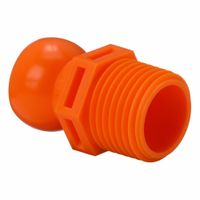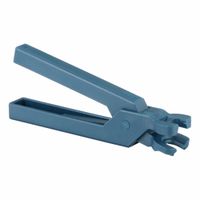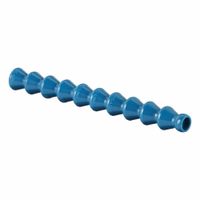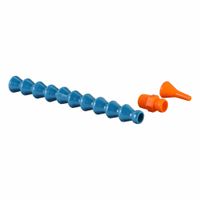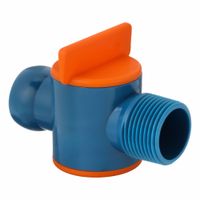Call +(254) 703 030 000 / 751 483 999 / 721 704 777
- Home
- Pipe Hose Tube Fittings
- Hose Hose Fittings Hose Reels
- Flexible Hose Systems
- Loc Line Coolant Hose Systems
.....Read More
Frequently Asked Questions
What is a Loc-Line coolant hose system?
A Loc-Line coolant hose system is a modular, flexible hose system commonly used in industrial and machining applications to direct coolant, air, or fluids precisely where needed. It is composed of interlocking ball-and-socket segments that allow for easy adjustment and positioning, providing a versatile solution for fluid delivery.
The system is made from durable, chemical-resistant materials, typically acetal copolymer, which ensures longevity and reliability in harsh environments. The modular design allows users to customize the length and configuration of the hose to suit specific requirements, making it adaptable to various machine setups and processes.
Loc-Line systems are available in different diameters, with the most common being 1/4", 1/2", and 3/4", to accommodate different flow rates and applications. The segments can be easily snapped together or apart, allowing for quick assembly and reconfiguration without the need for tools.
Accessories such as nozzles, valves, and connectors can be attached to the hose system to enhance its functionality. These components enable precise control over the direction, flow rate, and spread of the coolant or air, improving the efficiency of cooling and chip removal during machining operations.
The flexibility and adjustability of the Loc-Line system make it ideal for use in CNC machines, lathes, mills, and other equipment where targeted cooling or lubrication is essential. Its ease of use and adaptability help reduce setup times and improve operational efficiency, making it a popular choice in manufacturing and workshop environments.
How do you connect Loc-Line hoses to a coolant tank or air source?
To connect Loc-Line hoses to a coolant tank or air source, follow these steps:
1. **Select the Appropriate Loc-Line Size**: Determine the size of the Loc-Line hose needed for your application, typically available in 1/4", 1/2", 3/4", or 2.5" diameters.
2. **Choose the Right Fittings**: Obtain the necessary Loc-Line fittings and connectors that match the hose size and the connection points on your coolant tank or air source. Common fittings include NPT connectors, barbed fittings, and threaded adapters.
3. **Prepare the Connection Point**: Ensure that the connection point on the coolant tank or air source is clean and free of debris. If necessary, use Teflon tape on threaded connections to ensure a tight seal.
4. **Attach the Fitting to the Source**: Securely attach the chosen fitting to the coolant tank or air source. For threaded connections, screw the fitting into place, ensuring it is tight to prevent leaks. For barbed fittings, push the hose over the barb until it is snug.
5. **Connect the Loc-Line Hose**: Snap the Loc-Line hose onto the fitting. Loc-Line hoses are modular and can be easily snapped together or apart. Ensure that the hose is securely attached to the fitting.
6. **Adjust the Hose**: Position the Loc-Line hose as needed to direct the coolant or air flow to the desired location. The modular design allows for easy adjustment and repositioning.
7. **Test the Connection**: Turn on the coolant or air source to test the connection. Check for leaks and ensure that the flow is directed correctly. Make any necessary adjustments to the hose positioning or fittings.
8. **Secure the Setup**: Once satisfied with the setup, secure the hose and fittings to prevent movement during operation. Use clamps or brackets if necessary.
What are the benefits of using Loc-Line systems for coolant delivery?
Loc-Line systems offer several benefits for coolant delivery:
1. **Flexibility**: Loc-Line systems are highly flexible, allowing for easy adjustment and positioning of the coolant nozzles. This flexibility ensures precise targeting of the coolant to the desired area, improving cooling efficiency and effectiveness.
2. **Modularity**: The modular design of Loc-Line systems allows for easy assembly and reconfiguration. Users can customize the length and shape of the coolant lines to suit specific applications, making it adaptable to various machine setups and requirements.
3. **Durability**: Made from high-quality, chemical-resistant materials, Loc-Line systems are durable and can withstand harsh industrial environments. They resist wear and tear, ensuring a long service life and reducing the need for frequent replacements.
4. **Leak Resistance**: The tight-fitting segments of Loc-Line systems minimize the risk of leaks, ensuring that coolant is delivered precisely where needed without wastage. This efficiency helps in maintaining optimal coolant levels and reduces operational costs.
5. **Ease of Installation and Maintenance**: Loc-Line systems are easy to install and require minimal maintenance. The snap-together design allows for quick assembly and disassembly, facilitating easy cleaning and adjustments without the need for specialized tools.
6. **Versatility**: These systems can be used with a variety of coolants and are suitable for different machining processes, including milling, drilling, and turning. This versatility makes them a valuable addition to any machine shop.
7. **Cost-Effectiveness**: By improving coolant delivery efficiency and reducing waste, Loc-Line systems can lead to cost savings over time. Their durability and low maintenance requirements further contribute to their cost-effectiveness.
Overall, Loc-Line systems enhance the precision, efficiency, and reliability of coolant delivery in industrial applications.
How do you customize a Loc-Line coolant hose configuration?
To customize a Loc-Line coolant hose configuration, follow these steps:
1. **Select the Hose Diameter**: Choose the appropriate diameter for your application, typically 1/4", 1/2", 3/4", or 2.5".
2. **Choose the Components**: Identify the components needed, such as hose segments, nozzles, valves, and connectors. Each component is modular and can be snapped together.
3. **Determine the Length**: Calculate the total length required by adding the number of segments. Each segment adds a specific length, so plan accordingly.
4. **Select Nozzles**: Choose from various nozzle types like round, flat, or fan-shaped, depending on the spray pattern and flow rate needed.
5. **Add Valves and Flow Control**: Incorporate valves for on/off control and flow adjusters to regulate the coolant flow.
6. **Choose Connectors and Adapters**: Use connectors to join different hose sections or to attach the hose to machinery. Adapters may be needed to fit different thread sizes.
7. **Assemble the Hose**: Snap the segments and components together. The ball-and-socket design allows for easy assembly and adjustment.
8. **Adjust the Configuration**: Bend and position the hose to direct coolant precisely where needed. The flexible design maintains its shape during operation.
9. **Test the Setup**: Run coolant through the system to ensure there are no leaks and that the flow is directed correctly.
10. **Make Adjustments**: If necessary, disassemble and reconfigure components to optimize performance.
By following these steps, you can create a customized Loc-Line coolant hose configuration tailored to your specific needs.
What types of nozzles are available for Loc-Line systems?
Loc-Line systems offer a variety of nozzle types to cater to different applications and needs. These include:
1. **Standard Nozzles**: These are the basic nozzles used for general-purpose applications. They come in various diameters to control the flow rate and are suitable for directing coolant or air in machining operations.
2. **Flare Nozzles**: Designed to spread the flow over a wider area, flare nozzles are ideal for applications requiring a broader coverage, such as cooling larger surfaces or dispersing air over a wider area.
3. **Tapered Nozzles**: These nozzles provide a more concentrated and directed flow, making them suitable for precision applications where a focused stream is necessary.
4. **Ball Nozzles**: Featuring a spherical end, ball nozzles allow for easy adjustment and redirection of the flow. They are versatile and can be used in various settings where flexibility is required.
5. **Flat Nozzles**: These nozzles produce a flat, fan-shaped spray pattern, which is useful for covering a wide area with a thin layer of coolant or air.
6. **Extended Nozzles**: With a longer reach, extended nozzles are used to direct flow into hard-to-reach areas or deeper into machinery.
7. **Adjustable Nozzles**: These nozzles can be adjusted to change the flow pattern or direction, providing versatility for different tasks.
8. **Multi-Jet Nozzles**: Designed to split the flow into multiple streams, multi-jet nozzles are used for applications requiring simultaneous coverage of multiple points.
9. **Swivel Nozzles**: Allowing for 360-degree rotation, swivel nozzles offer maximum flexibility in directing the flow precisely where needed.
These nozzles can be combined with various Loc-Line hose sizes and fittings to create customized solutions for specific industrial or hobbyist applications.
How do you maintain and clean Loc-Line coolant hoses?
To maintain and clean Loc-Line coolant hoses, follow these steps:
1. **Regular Inspection**: Frequently check the hoses for any signs of wear, leaks, or blockages. Look for cracks or damage that might affect performance.
2. **Disassembly**: Carefully disassemble the Loc-Line hoses. They are modular, so gently twist and pull apart the segments. This allows for thorough cleaning and inspection of each piece.
3. **Cleaning**: Use a mild detergent mixed with warm water to clean the hoses. Submerge the segments and use a soft brush to scrub away any debris, coolant residue, or buildup. Avoid harsh chemicals that could degrade the plastic.
4. **Rinsing**: Rinse each segment thoroughly with clean water to remove any soap residue. Ensure all detergent is washed away to prevent contamination of the coolant system.
5. **Drying**: Allow the segments to air dry completely. Ensure no moisture remains inside the segments to prevent bacterial growth or corrosion in the coolant system.
6. **Reassembly**: Once dry, reassemble the Loc-Line hoses by snapping the segments back together. Ensure a secure fit to prevent leaks.
7. **Lubrication**: If necessary, apply a small amount of food-grade silicone lubricant to the joints to facilitate smooth movement and prevent wear.
8. **Reinstallation**: Reattach the hoses to the machine, ensuring they are properly aligned and securely fastened to prevent leaks or dislodgement during operation.
9. **Testing**: Run the coolant system to check for leaks and ensure proper flow. Adjust the hoses as needed to direct coolant accurately.
10. **Routine Maintenance**: Establish a regular maintenance schedule to inspect and clean the hoses, ensuring optimal performance and longevity.
What are common applications for Loc-Line systems beyond coolant delivery?
Common applications for Loc-Line systems beyond coolant delivery include:
1. **Fume Extraction**: Loc-Line systems are used to create flexible fume extraction arms in laboratories and workshops, allowing for the safe removal of hazardous fumes and vapors from work areas.
2. **Airflow Control**: They are employed in various settings to direct airflow for cooling or ventilation purposes, such as in electronics cooling or HVAC systems.
3. **Lighting**: Loc-Line systems can be used to position and hold lights in place, providing adjustable and precise lighting solutions for photography, inspection, or workstations.
4. **Camera and Sensor Mounting**: The flexible nature of Loc-Line makes it ideal for mounting cameras and sensors in industrial and research environments, allowing for easy repositioning and stability.
5. **Aquarium and Terrarium Applications**: In aquariums, Loc-Line is used to direct water flow, create custom filtration systems, or position feeding tubes. In terrariums, it can be used for misting systems or to direct airflow.
6. **3D Printing**: Loc-Line systems are used to direct cooling air onto prints, improving print quality and reducing warping by providing consistent airflow.
7. **Dust Collection**: They are utilized in woodworking and other industries to create flexible dust collection systems, helping to maintain clean and safe work environments.
8. **Medical and Dental Equipment**: Loc-Line systems are used in medical and dental settings to position suction devices, lights, or other instruments, providing flexibility and ease of use.
9. **Educational and Demonstration Tools**: In educational settings, Loc-Line can be used to create interactive models or demonstration tools, allowing for hands-on learning experiences.
10. **Robotics and Automation**: Loc-Line systems are used in robotics for cable management or to position sensors and tools, offering flexibility and adaptability in automated processes.
